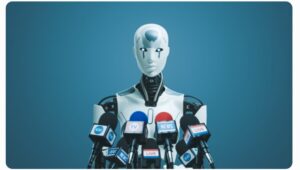Top List of Generative AI Tools For Text, Image, Music & Video Creation
Generative AI tools are transforming the way people create and innovate across various fields.
From content creation to coding, these tools offer the ability to generate new and unique outputs based on input data.
Generative AI allows users to create text, images, music, and more with just a few prompts, making tasks easier and faster.

For those interested in exploring these tools, platforms like ChatGPT by OpenAI and DALL-E 2 provide opportunities to engage with generative AI.
These tools are popular for their ability to produce creative content and improve efficiency in various industries.
As generative AI continues to evolve, its applications are expanding, impacting fields such as design, programming, and art.
Users can dive into generative AI tools to discover new ways to enhance their projects and streamline their work processes.
Overview of Generative AI
Generative AI is a powerful technology that creates new content, such as images, text, and music, from existing data.
It uses advanced algorithms and machine learning models to produce outputs that are highly realistic and diverse.
Generative AI refers to systems that can create new content by learning from existing data.
These systems are designed to produce outputs that are both novel and realistic.
Unlike traditional AI, which focuses on pattern recognition and prediction, generative AI synthesizes data to create something new.
This includes generating text, music, art, and even complex simulations.
In essence, generative AI works by identifying patterns from large datasets.
It then uses these patterns to make informed guesses about what to generate next.
This ability makes it highly valuable across various industries, from entertainment to healthcare.
Top List of Generative AI Tools – Text
Generative AI tools have become indispensable for automating text generation, making content creation faster and more efficient. Here’s a comprehensive list of the top text-based generative AI tools available today.
1. ChatGPT (OpenAI)
Use Case: Conversational agents, creative writing, customer support.
ChatGPT is a leading generative AI tool widely used for drafting emails, writing articles, and automating chatbots. Learn more here.
2. Jasper.ai
Use Case: Content creation for blogs, emails, and ads.
Jasper.ai generates persuasive copy and blog content, helping marketers save time and scale their content production. Learn more here.
3. Writesonic
Use Case: Blog posts, marketing copy, product descriptions.
Writesonic is a generative AI tool that creates SEO-optimised articles, enhancing content marketing strategies. Learn more here.
4. Copy.ai
Use Case: Social media posts, email marketing, and website copy.
Copy.ai allows marketers to produce high-quality content for social media and digital marketing campaigns quickly. Learn more here.
5. Rytr
Use Case: Blog writing, idea generation, and copywriting.
Rytr is designed to help users generate content quickly, offering templates for blogs, emails, and more. Learn more here.
6. Anyword
Use Case: Marketing copy, landing page optimisation.
Anyword is an AI-driven copywriting tool that assists in writing persuasive and conversion-focused content. Learn more here.
7. CopySmith
Use Case: Ecommerce product descriptions, ads, and blogs.
CopySmith focuses on e-commerce businesses by helping generate product descriptions, blogs, and advertising copy. Learn more here.
8. QuillBot
Use Case: Paraphrasing, grammar correction, and summarisation.
QuillBot offers a suite of tools for rephrasing content, summarising articles, and improving writing style. Learn more here.
9. ContentBot
Use Case: AI content automation, short and long-form content.
ContentBot helps create a wide range of content types, from quick product descriptions to long-form blogs. Learn more here.
10. Peppertype.ai
Use Case: Social media content, ad copy, and email drafts.
Peppertype.ai generates high-quality content specifically tailored for digital marketers, bloggers, and advertisers. Learn more here.
Top List of Generative AI Tools – Image
Generative AI tools have transformed the way images are created, allowing users to generate high-quality visuals from text prompts and other inputs.
Here’s a curated list of the top image generative AI tools available, each designed to cater to different creative needs.
1. DALL·E 2 (OpenAI)
Use Case: Artistic image creation from text descriptions.
DALL·E 2 is an AI tool that generates realistic and artistic images based on detailed text prompts, making it a favourite among artists and designers. Learn more here.
2. MidJourney
Use Case: Digital art generation.
MidJourney excels in generating stunning, creative images from text prompts, particularly in the realm of abstract and surreal digital art. Learn more here.
3. Stable Diffusion
Use Case: Customisable image creation with open-source support.
Stable Diffusion allows users to generate detailed images using AI, offering flexibility for those who want more control over their creations. Learn more here.
4. RunwayML
Use Case: Video editing and image generation.
RunwayML provides advanced tools for creating images and videos, allowing artists and content creators to produce high-quality, AI-enhanced visuals. Learn more here.
5. Deep Dream Generator
Use Case: Artistic transformations of existing images.
Deep Dream Generator uses AI to turn simple photos into dream-like, surreal artwork, popular among artists looking for unique styles. Learn more here.
6. Artbreeder
Use Case: Collaborative image creation through AI.
Artbreeder blends AI and creativity, allowing users to create new images by mixing and evolving existing ones, perfect for creative experimentation. Learn more here.
7. Canva (AI-Powered Tools)
Use Case: Graphic design and marketing visuals.
Canva integrates AI to help users generate images, offering templates and design tools for marketing, social media, and personal projects. Learn more here.
8. DeepAI Image Generator
Use Case: Quick, text-based image generation.
DeepAI offers a simple yet powerful tool for generating images from text prompts, useful for digital marketers and content creators. Learn more here.
9. Craiyon (formerly DALL·E Mini)
Use Case: Free, quick image generation from text.
Craiyon is a free-to-use AI image generator that transforms text into images, ideal for users looking for a quick, accessible tool. Learn more here.
10. Designify
Use Case: Automatic photo enhancement and editing.
Designify uses AI to generate and enhance images, offering a simple solution for photo editing and automatic background removal. Learn more here.
Top List of Generative AI Tools – Music
Generative AI tools are reshaping the music industry by enabling artists, producers, and enthusiasts to compose and create original music effortlessly. Below is a top list of music generative AI tools, along with their specific use cases.
1. AIVA
Use Case: AI-powered composition for soundtracks and classical music.
AIVA is one of the most advanced generative AI tools for music composition, often used for film scores and background music. Learn more here.
2. Amper Music
Use Case: Custom music creation for videos and content.
Amper Music allows users to create unique soundtracks by selecting mood, genre, and length, perfect for content creators and marketers. Learn more here.
3. Soundraw
Use Case: AI-generated music for commercials and branding.
Soundraw is designed to help users create royalty-free music for commercial purposes, especially for branding and advertisements. Learn more here.
4. JukeBox (OpenAI)
Use Case: AI music generation in various genres and artist styles.
JukeBox generates original music in different styles and even mimics the voices of famous artists, providing an experimental edge to music creation. Learn more here.
5. Boomy
Use Case: Fast music creation for streaming and sharing.
Boomy allows anyone to compose and release music within minutes, ideal for aspiring artists looking to distribute their work online. Learn more here.
6. Ecrett Music
Use Case: Background music for videos, games, and apps.
Ecrett Music generates custom background music that suits a wide range of use cases like gaming, videos, and mobile apps. Learn more here.
7. Melodrive
Use Case: Real-time adaptive music for games and interactive media.
Melodrive creates dynamic, adaptive music tailored to interactive experiences like video games and virtual environments. Learn more here.
8. Amadeus Code
Use Case: Songwriting assistance using AI-generated melodies.
Amadeus Code is a generative AI tool for musicians and songwriters, offering inspiration and creating new melodies to help with the songwriting process. Learn more here.
9. Endel
Use Case: Personalised soundscapes for productivity and relaxation.
Endel generates music designed to improve focus, relaxation, and sleep, using AI to adapt to the user’s environment and mood. Learn more here.
10. Loudly
Use Case: AI music generation for social media and short-form videos.
Loudly offers a library of AI-generated music specifically tailored for social media platforms like TikTok and Instagram. Learn more here.
Top List of Generative AI Tools – Video
The rise of generative AI tools for video creation has transformed the creative process by enabling automation and enhancing production quality. Below is a list of top generative AI tools designed specifically for video production, editing, and content creation.
1. Synthesia
Use Case: AI video generation with human-like avatars.
Synthesia allows users to create professional videos using AI-generated avatars, making it ideal for corporate training, marketing, and explainer videos. Learn more here.
2. RunwayML
Use Case: AI-enhanced video editing.
RunwayML provides powerful tools for video creators, offering features like background removal, video inpainting, and text-to-video generation. Learn more here.
3. Pictory
Use Case: Video creation from text content.
Pictory turns written content, such as blog posts or articles, into engaging videos, perfect for content marketers and social media managers. Learn more here.
4. Lumen5
Use Case: Automated video creation for social media.
Lumen5 is designed to transform blog content, articles, and text into high-quality social media videos, making it a go-to tool for marketers. Learn more here.
5. DeepBrain
Use Case: AI avatar video creation from text input.
DeepBrain allows users to create AI-driven avatar videos by simply typing in the script, useful for educational content and tutorials. Learn more here.
6. Elai.io
Use Case: Video generation with custom AI avatars.
Elai.io helps users create AI-generated videos featuring custom avatars, particularly useful for businesses looking to create scalable video content. Learn more here.
7. InVideo
Use Case: AI-assisted video editing and creation.
InVideo automates video editing with AI features such as text-to-video conversion and social media optimisation, ideal for marketers and content creators. Learn more here.
8. Veed.io
Use Case: Video editing and subtitling with AI features.
Veed.io offers video editing tools enhanced by AI, including automatic subtitling and transcription, perfect for social media and online content creators. Learn more here.
9. Descript
Use Case: AI-powered video editing with transcription.
Descript simplifies video editing with AI tools, allowing users to edit videos by editing the transcript. It’s great for podcast videos, webinars, and tutorials. Learn more here.
10. Magisto
Use Case: Automated video editing for marketing.
Magisto uses AI to automatically edit and generate videos from user-provided footage, making it perfect for quick video creation for social media. Learn more here.
Generative AI tools are revolutionising video production by making it faster and more accessible for content creators. Whether you’re creating marketing videos, educational content, or social media clips, these tools can streamline your workflow and enhance the quality of your output.
Conclusion
Generative AI tools have become essential in multiple industries. They not only boost productivity but also enhance creativity.
Businesses, schools, and individuals can benefit from these tools.
In content creation, AI tools like those using the GPT-3.5 system help streamline writing processes. They offer creative solutions quickly and effectively, making them valuable for marketers and writers alike.
In addition to writing, AI assists in creating videos, images, and even music. Jasper and Anyword excel in generating marketing content, providing diverse options for digital campaigns.
Many AI tools are user-friendly and accessible. They require minimal technical skills, allowing easy integration into daily tasks. This accessibility makes them appealing to a wide audience.
Cost-effectiveness is another advantage. These tools often reduce the time and resources needed for various projects. By automating routine tasks, they allow professionals to focus on more complex challenges.
Below are some key benefits of generative AI tools:
- Creativity: Spark new ideas and inspiration.
- Efficiency: Save time on repetitive tasks.
- Flexibility: Adapt to various projects and industries.
For more on these tools, Zapier offers a comprehensive list, while Ahrefs provides options for crafting conclusions.
The rapid advancements in generative AI signify an exciting era of innovation and opportunity.




















